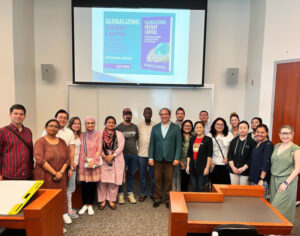By Heba Labib, Egypt
 Today marks the last working day of a six-week-long SUSI program. The Study of US Institutes program, sponsored by the US Department of State and managed by ITD (The Institute for Training and Development), hosts 18 scholars from around the globe, with varied backgrounds, yet a common interest in learning about the US economy and sustainability. The day was a miniaturized version of the whole program, featuring academics, culture, nature, and friendly company.
Today marks the last working day of a six-week-long SUSI program. The Study of US Institutes program, sponsored by the US Department of State and managed by ITD (The Institute for Training and Development), hosts 18 scholars from around the globe, with varied backgrounds, yet a common interest in learning about the US economy and sustainability. The day was a miniaturized version of the whole program, featuring academics, culture, nature, and friendly company.
The final day of classes was held at George Washington University, where we attended a lecture titled: “Globalizing Patient Capital.” The lecture discussed the Chinese finance of mega-scale infrastructure projects in developing countries (with a focus on South America). The lecturer, Prof. Stephen Kaplan, tracked the development and growth of Chinese financing over the years. China is now one of the major five financing nations, competing with the UK, the US, Germany, and Japan. Within this scenario, China is capitalizing on its financing capability to expand its market reach in previously untapped markets, and expanding its scope of business to include the export of services and know-how over and above products and machinery.
 The Chinese financing model offers a lot more lenient financing conditions as opposed to the IMF and the World Bank and does not require an intervention in a country’s financial or fiscal policies. Nonetheless, the commercial conditions of the Chinese loans are rather stringent, with fine print that may lead to countries falling into the “Debt Diplomacy Trap.” In such an unfortunate case, a country may lose control over its assets.
The Chinese financing model offers a lot more lenient financing conditions as opposed to the IMF and the World Bank and does not require an intervention in a country’s financial or fiscal policies. Nonetheless, the commercial conditions of the Chinese loans are rather stringent, with fine print that may lead to countries falling into the “Debt Diplomacy Trap.” In such an unfortunate case, a country may lose control over its assets.
Developing countries have to face the tough choices of building their own long-overdue infrastructure projects, yet also face the repercussions of increased debt. The way out is for such countries to run proper feasibility studies and use prioritization to limit falling into the trap of increasing debts. Moreover, such countries need to adopt proper governance mechanisms to ensure transparency and minimize corruption, and hence maximize benefits for the country.
Following the class, we had lunch at a Honduran restaurant recommended by Marlene Dominiguez, our Honduran colleague. We tried the pupusas along with other Central American recipes.
And that marked the first half of the day. The day then continued with a visit to the National Gallery in Washington, DC. I only managed to visit the classical half of the gallery, which was quite rich in works of art. There was plenty of Dutch and Flemish art, with a few Rembrandts, and many Dutch and Flemish artists, displayed in one exhibit after the other. And one can wonder, how come there are so many artists from such a small region, as if the children there are born with a brush in their hand.
The Gallery had an impressive collection from the masters, especially the 19th-century exhibit, which featured works of Van Gogh, Renoir, and Monet.




It was unfortunate that I could not finish the modern art exhibits in the National Gallery, as it closed its doors at five o’clock, and so I had to leave.
We went for a stroll to the botanical gardens, where the garden itself was still open. The most captivating sight was a white squirrel, which for me, was the first time to see one.
One is full of mixed emotions. As much as I am excited that I will get back to my family after such a long absence, I am already missing the SUSI experience. It has been a rich and densely packed six weeks where we have been exposed to a multitude of domains, covering but not limited to: political economy, blue economy, green infrastructure, fiscal and monetary policy, fintech, entrepreneurship, pedagogical approaches, etc. Meanwhile, the program was heavily enriched with cultural content and experiential learning; in addition, I felt privileged to be surrounded by such exceptional individuals from all around the globe. I really feel thankful for being part of such a program.


All opinions expressed by the program participants are their own and do not represent nor reflect official views from the Bureau of Educational and Cultural Affairs of the U.S. Department of State, or of the Institute for Training and Development, Inc.




